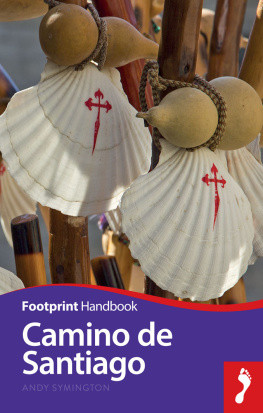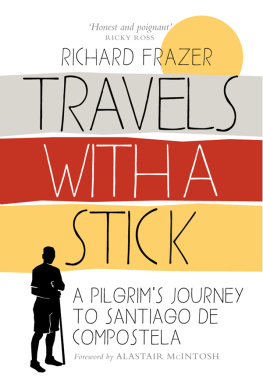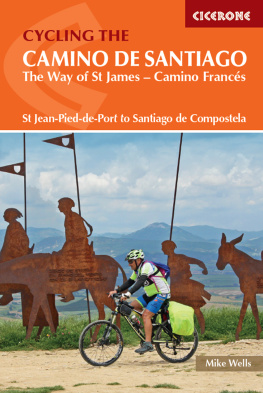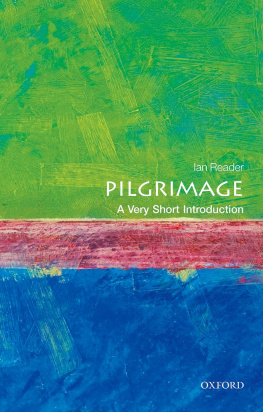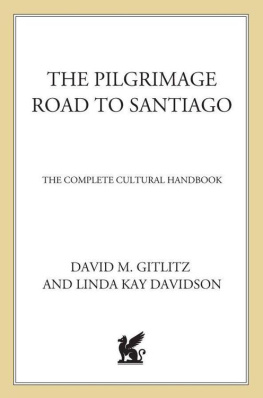Table of Contents
TO SANTIAGO
The Four Roads To Heaven
Edwin Mullins
Photographs by Adam Woolfitt
Hornbeam Press

Copyright
Copyright 2014 by Edwin Mullins
Edwin Mullins has asserted his right to be identified as the author of this work
ISBN: 978-0-9928140-3-8
Published by Hornbeam Press www.hornbeampress.co.uk
All rights reserved. Without limiting the rights under copyright reserved above, no part of this publication may be reproduced, stored in or introduced into a retrieval system, or transmitted, in any form, or by any means (electronic, mechanical, photocopying, recording, or otherwise) without the prior written permission of both the copyright owner and the above publisher of this book.
License Notes
This ebook is licensed for your personal enjoyment only. This ebook may not be re-sold or given away to other people. If you would like to share this book with another person, please purchase an additional copy for each person you share it with. If youre reading this book and did not purchase it, or it was not purchased for your use only, then you should purchase your own copy. Thank you for respecting the authors work.
CONTENTS
Preface
The Road from Paris
Chapter 1 Setting Out
Chapter 2 Along the Loire
Chapter 3 A Brave New World
Chapter 4 Churches more beautiful than before
Chapter 5 Battles Long Ago
Chapter 6 To the Bad Lands and the Good Lands
The Road fromVzelay
Chapter 7 The Magdalene and Sacred Theft
Chapter 8 The Broader Picture
Chapter 9 Cluny Triumphant
Chapter 10 On the Miracle Trail
The Road from Le Puy
Chapter 11 A Gift of many Gods
Chapter 12 Golden Majesty
Chapter 13 Tall Tales and Wild Beasts
Chapter 14 Crosses on a Mountain-top
The Road from Arles
Chapter 15 Roman Footprints
Chapter 16 Desert Songs
Chapter 17 A Cargo of Relics
Chapter 18 Into Spain
The Spanish Road
Chapter 19 The Way of St James and Crowning Glory
PREFACE
There are four roads leading to Santiago, and they converge to form just a single road.
These are the opening words of a book, written almost a thousand years ago, that can lay claim to be the worlds first travel guide. The book (in Latin) is the Liber Sancti Jacobi , the Book of St James, generally known simply as the Pilgrims Guide . It forms part of a larger manuscript known as the Codex Calixtinus, named after Pope Calixtinus II (d. 1124). The Pilgrims Guide was probably written, or at least compiled, by a Benedictine monk or perhaps several monks early in the 12th century under the auspices of the powerful Burgundian monastery of Cluny. And it was put together for the benefit of pilgrims who were proposing to travel to the tomb of the apostle St James the Greater at Santiago de Compostela in northwest Spain.
The Pilgrims Guide has an undisguised agenda, which is to promote the pilgrimage. The manuscript once existed in a number of copies, only two of which survive, one in the cathedral library of Santiago itself and the other at Ripoll monastery in northeast Spain. Originally copies would have been available in the libraries of monasteries that were associated with the great pilgrimage. Only a tiny literate minority would have been able to take advantage of the Pilgrims Guide , but its message filtered down through the ranks nonetheless, and it is estimated that at the height of the St James cult in the 12th century about half a million travellers used to undertake that journey to Santiago each year.
The four roads listed in the Guide are all in France, and they form the principal threads of a spiders web of pilgrim roads laid across the landscape of the country. They are the roads I shall be following in this book, seeking out what has survived of the mediaeval world it describes. I shall be the invisible traveller on a journey of today and yesterday, exploring the range of magnificent buildings and works of art which are the legacy of that pilgrimage over the years, as well as trying to capture something of the spirit of hope and endeavour which drove our ancestors to make that same journey all those centuries ago.
Many years ago I wrote an account of my first travels along these pilgrim roads. Called The Pilgrimage to Santiago , it was published in 1974 and reissued in paperback in the millennium year 2000, and is now long out of print. The book was a younger mans journey of discovery, and the experience of making that journey has remained vivid in my mind ever since. The first impact on a traveller of the abbey church of Conques or the cathedral of Santiago can never weaken, and without those early experiences, and countless others, this present book could never have been written. At the same time, much work has been done since then on the theme of the great pilgrimage to Santiago and on subjects related to it, including my own book on the history of Cluny, the great Burgundian abbey which was responsible to a large extent for making the mediaeval pilgrimage possible.
This new study is a fresh look at an old friend.
*
On several of my journeys to France and Spain I was fortunate in being accompanied by one of Englands most distinguished photographers, Adam Woolfitt. Our collaboration was made possible by the benign editor of the Daily Telegraph Magazine, who was in the priceless habit of allowing me to write on more or less any subject that he sensed would make good copy and good pictures. These were the glorious salad days of the colour supplement. Writers and photographers thrived, and Adam and I worked together for some 15 years in various parts of the world.
Our travels along the mediaeval pilgrim roads were among the most rewarding of these enterprises, with both of us responding with delight and amazement at the riches of art, architecture and landscape that were opened up before us. It is now with deep gratitude to Adam that I have the opportunity to enjoy again some of the images of those journeys in this present book.
*
About the Cover Photograph
Many years ago, while I was exploring the old pilgrim roads in southwest France, I met a local doctor in the small town of Saint-Palais in the Basque country. He was Dr. Clment Urrutibhtty who had to be a Basque with a name like that and in addition to being a medical practitioner he was also a historian who knew more than anyone about ancient roads in this region. It was he who had been responsible for identifying the exact place in the nearby hills where three of the main pilgrim roads to Santiago became one, before heading to the Pyrenees and Spain. The doctor had recently arranged to erect a small monument to mark the spot, surmounted by a traditional Basque headstone. Hed be delighted to take me there, he said. And we drove up into the hills to where the monument stood.
A short while later Adam Woolfitt joined me, and he photographed it. This Basque headstone standing at the junction of the three ancient roads, now little more than farm-tracks, bears the weight of a thousand years of history.
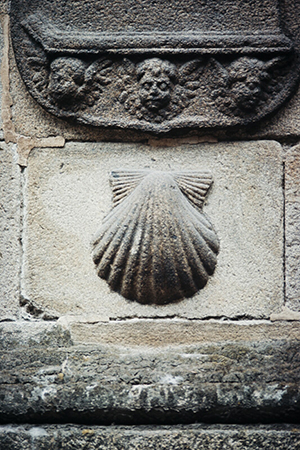
The scallop shell, symbol of St Jamess arrival in Spain by sea and emblem of the Santiago pilgrimage: carved on churches and worn on pilgrims clothing


